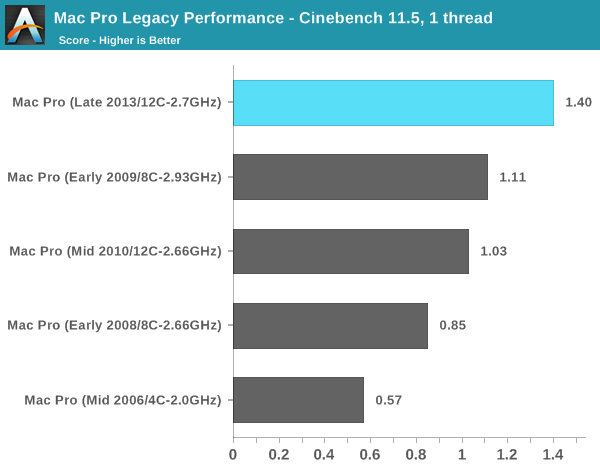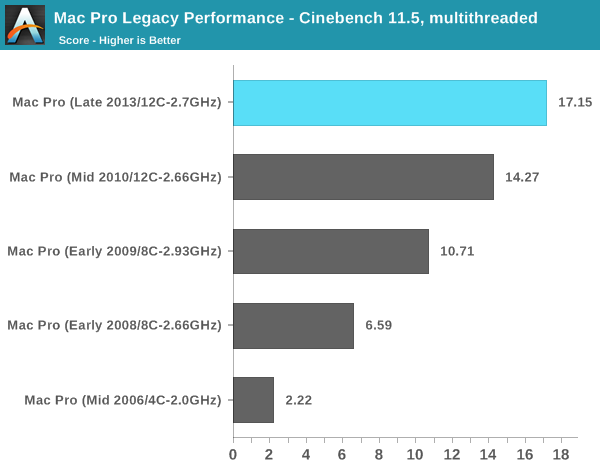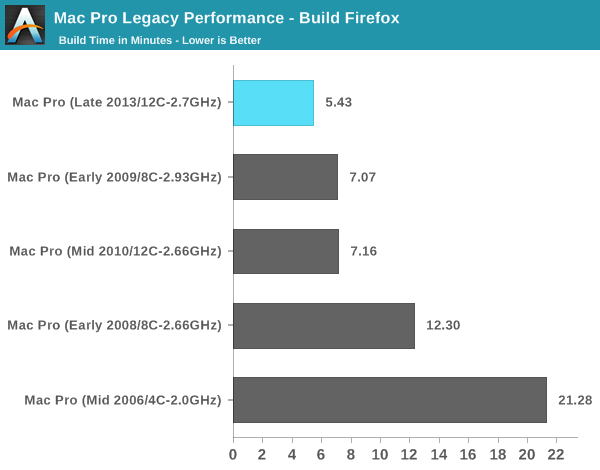The Mac Pro Review (Late 2013)
by Anand Lal Shimpi on December 31, 2013 3:18 PM ESTCPU Performance
I like to have large historical databases of performance so I can put new products in perspective. The Mac Pro and its funny lineage make this a little difficult. For starters, I simply haven't reviewed all of the Mac Pro CPU combinations that have existed over the years. Then there's also the fact that not all of my Mac suite applies well to a 12-core/24-thread Mac Pro. I'm going to try my best to put the new Mac Pro's performance in perspective, but it's going to require a couple of subsections.
Let's first start with a look at the historical performance of the Mac Pro. I really have to thank @elfurberino and @tapbot_paul for lending their time (and their Mac Pros) to help flesh out this comparison. With their help I managed to put together performance data for almost every single generation of Mac Pro.
We'll start with Cinebench R10's single threaded test. Unfortunately the benchmark crashes on Macs with 16+ threads so single threaded performance is all we'll be able to look at:

That's right, I still have my old PowerMac G5 Dual 2.5GHz (upgrade from my original 2.0 model). It's interesting to note that single threaded performance has only improved by 2.8x over that 2.5GHz dual G5 machine from around a decade ago. If we were able to also look at multithreaded performance we'd see a much larger gap. The dual G5's multithreaded performance is actually lower than the single threaded performance of the new Mac Pro's IVB-EP (3346 vs 5187). And the new Mac Pro has 12 of those cores.
Here you can see a very healthy increase in single threaded performance over the 2010/2012 12-core system. The 34% increase in performance is because the Mac Pro never got the Sandy Bridge bump. All previous Mac Pros topped out at Nehalem/Westmere. Couple all of the Sandy Bridge improvements with the much higher peak clock speeds (3.5GHz vs. 3.0GHz) and the performance gains make sense.
The 8C system from early 2009 gives us an example of how it's very possible to have a newer Mac Pro actually perform worse than its predecessor. Apple has done a relatively good job this round of keeping the core count/frequency tradeoffs sensible, but you still have to align your silicon choices to your workload.
Moving on to Cinebench 11.5, we lose the PowerMac G5 comparison but we gain a more modern benchmark. Once again we'll start with the single threaded numbers:

There's that healthy single threaded performance bump again. It is pretty incredible to me just how far we've come in single threaded performance since the mid-2000s. What's even crazier is that 2.0GHz Mac Pro from 2006 is only about 40% faster than a Bay Trail tablet with an Atom Z3770.

The multithreaded story is more evolutionary for sure, especially compared to the previous generation 12-core model. Here we're showing a 20% gain over the previous 12-core design. If you're migrating from a machine with fewer cores you can expect a corresponding increase in multithreaded performance. What is most surprising here is that a 2.3GHz 15-inch MacBook Pro with Retina Display (Late 2013) actually offers better multithreaded performance than the 8-core 2.66GHz Mac Pro from early 2008 in the chart above. The new 15-inch rMBP scores a 6.62 here compared to the 6.58 of that old Mac Pro.
I also shared my Firefox build test with Adam and Paul, who helped me fill out the chart below:

There isn't much of an advantage to having 12 cores here, but the new Mac Pro does deliver an amazingly quick build time compared to anything else. The new Mac Pro is good for around a 24% improvement in build performance compared to the outgoing 12-core model.










267 Comments
View All Comments
frelledstl - Tuesday, December 31, 2013 - link
"I have to admit that I've been petting it regularly ever since. It's really awesomely smooth. It's actually the first desktop in a very long time that I want very close to me."You lost me here dude. Scary...
lilo777 - Tuesday, December 31, 2013 - link
It's jusr AT delivering main Apple talking points. After all small size is the only [questionable] benefit of MP. How else can they justify skimping on GPU power no expandability etc.darkcrayon - Wednesday, January 1, 2014 - link
Ahh yes, a willfully ignorant troll on any forum. "No expandability"...akdj - Wednesday, January 1, 2014 - link
Lol...you're baaaack! To spew more bullshit? Expandability skimping? Developing thunderbolt hand in hand with Intel, decreasing the weight from 70 to 10 pounds yet blowing the doors off its predecessor with its 'skimpy' GPU offerings....hmmm, I'll take two. Sorry you've no need for the machine. Many that do will easily save time.....which in turn allows the computer to make more money....which allows it to pay for itself.Engineering art AND function AND the balls to pull it off
Are you still missing your Soundblaster? Your serial and parallel connections?
I'd like to think LILO has a life....but it's pretty much a given, ANY Apple story, review, even objective measurements Anand and team provide, LILO will be here....fast as he can. Quarterbacking from mom's basement with his Pentium 4 and Voodoo3DFX....feed the spider dude. Get out. Get some air. Then learn about computers. It wouldn't waste as much 'comment' space. You're obviously in need of an xbox...not a workstation with MORE Expandability than any other computer on the market and weighing a bit more than Dell and HP's 'workstation' laptops. Wow. Just. Wow. Hopefully some day anonymity will be taken away in these comment sections. Would make it nice to know some folks would just find a different place to troll
bji - Thursday, January 2, 2014 - link
That's alot of hate for something so insignificant.Dennis Travis - Thursday, January 2, 2014 - link
He probably uses an old Adlib card and not even a soundblaster! :D Grin it's been so long I actually had google to remember the name Adlib!KVFinn - Tuesday, December 31, 2013 - link
People have been avoiding crossfire AMD chips for awhile because of frame pacing issues (high frame but with stutters and frames out of sequence so looks worse overall) AMD recently fixed this but only in the 290 model. Do the D700s suffer from this issue in windows gaming?Ryan Smith - Tuesday, December 31, 2013 - link
Yes. D700s are Tahiti based and as such have all the same limitations as the 7970/280x parts, where it has yet to be fixed for Eyefinity configurations (including tiled monitors).mesahusa - Thursday, January 9, 2014 - link
why in hell would you even ask such a stupid question? its pretty obvious that this is for video editors and movie makers, not gamers -_-solipsism - Tuesday, December 31, 2013 - link
Where is the Single Threaded Performance for the first graph on page 2?